

 |
||
 |
||
Vol. 7 (1): June 2004 |
Download this page
|
|
Greece / Israel / Madeira / Mauritania & Western Sahara / Turkey
Israel
|
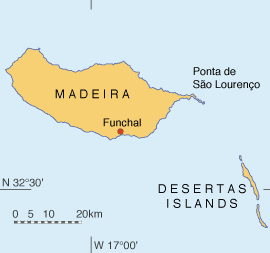 |
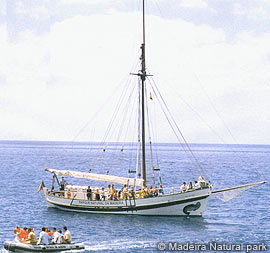 |
|
|
Madeira and the Ponta de São Lourenço. |
The Natural Park boat, “Buteo”. |
Public awareness has been mainly directed towards schools and coastal communities with the aim of advising people how behave if they encounter a monk seal.
The Madeira Natural Park boat “Buteo” is used to promote the visits to the monk seal habitat in the middle schools. – Rosa Pires, Parque Natural da Madeira.
Further information
Parque Natural da Madeira. 2003. Help us to help the monk seal. English brochure and sighting register: 1-2. [![]() 1.3MB]
1.3MB]
For new insights into mother-pup behaviour in the Desertas Islands, see this issue’s In Focus, One pup - three “mothers” by Rosa Pires.
As a result of the continuous monitoring performed at Cabo Blanco during these last years, it has been possible to detect signs of a possible recovery in the monk seal colony, after it was decimated by the 1997 mass die-off that in a few months killed two thirds of the total seal population, 99% of them adults.
Counts of individuals performed at low tide in the two main caves used by seals suggests that this recovery is taking place. Although providing grounds for optimism, however, such information needs to be taken with caution. From 1997 until 2000, counts failed to show more than 45 animals in both caves. However, since 2001, when a maximum of 57 animals were counted, the occupation of caves has shown a slow but continuous growth. In 2004, maximum counts are around 70 animals, and a count performed not at low tide showed 89 animals in one of the caves.
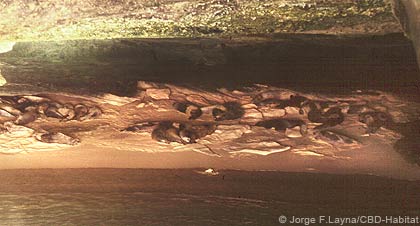 |
|
Monk seals in a Cabo Blanco breeding cave. |
In parallel to this possible recovery of the colony, a re-colonization of its local distribution area has also been detected – specifically, in the area north of the breeding caves, where seals almost disappeared after the mass die-off. This is a 7.2 km area dominated by cliffs in which some adult males of the colony are established and maintain aquatic territories. Prior to the die-off, up to 24 animals were recorded there. Following that event and up until 2002, 4 animals were regularly observed there. During the last marine expeditions to the area undertaken at the end of 2003, however, up to 15 different adult males were observed under the cliffs.
Also, the incidence of (non-pup) seals found dead on the regularly-patrolled beaches south of the breeding caves has shown a promising decrease. The average number of carcasses located each year was 4 but has decreased to one in these last two years. In May 2001, fishing gear began to disappear from the entrance of the breeding caves and from the areas used regularly by seals.
The colony’s productivity remains constant during the last years, maintaining an average of 25 annual births and pup mortality rates fluctuating between 40 and 55%, depending on the weather conditions of each year.
Taken collectively, the data makes us guardedly optimistic about the recovery of the Cabo Blanco monk seal colony. – Miguel Angel Cedenilla & Pablo Fernández de Larrinoa, CBD-Habitat.
Amrigue is already 7 years old. Rescued as a one month old pup during the 1997 mass die-off that claimed the life of his mother, he is now an adult male. Regular observations seem to indicate that he moves around Greyhound Bay.
He was born in one of the Cabo Blanco breeding caves and rescued on 24 May 1997. After a rehabilitation period of 4 months in the Mauritanian Institute of Oceanographic and Fisheries Research (IMROP), he was released on 20 September. Prior to the release, plastic tags were applied to its rear flippers, as well as a satellite transmitter that allowed tracking during the following 55 days.
Immediately alter his release, he moved towards the south of the Cabo Blanco peninsula and the Banc D’Arguin National Park area. He spent almost two months in this area moving back and forth and even suffered a capture attempt on a National Park beach by a fisherman who thought he was something “eatable”. In November 1997, tracking signals were lost just as he was entering Greyhound Bay (Levrier Bay).
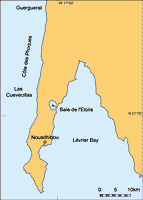 |
|
|
click to enlarge |
Since then, however, Amrigue has been sighted on several occasions by fishermen, and members of IMROP and CBD-Habitat. In 1998 he was observed and identified near the Bay of the Star (Baie de L’Etoile), a small bay inside Greyhound Bay. Later on, we learnt about his progress thanks to interviews with the fishermen of the area who even told us that he had moulted, attaining the typical adult male black pelage.
At the end of 2003, he was located once again and identified thanks to the plastic tags that he still has on his rear flippers. Since then, he is observed frequently at specific points of Greyhound Bay, allowing monitoring of his locations and movements.
Despite his healthy condition, Amrigue has not been seen and identified in the breeding caves area, on the opposite side of the Cabo Blanco peninsula. The distance which separates the breeding caves from Amrigue’s location is around 80 km. This distance should not be a problem for a monk seal, but the territorial behaviour of adult males makes us think that he maintains an aquatic territory inside the Bay. Hopefully, time will tell us about his movements and about how his behaviour develops. – Miguel Angel Cedenilla & Pablo Fernández de Larrinoa, CBD-Habitat.
In April, technicians at the Mauritanian Institute of Oceanographic and Fisheries Research (IMROP) informed CBD-Habitat staff that a monk seal carcass had been found on Mamghar’s beach, at the southern limit of Banc D’Arguin National Park. The distance from the Cabo Blanco monk seal colony is around 400 km. The carcass was in a decomposed state, preventing the taking of necropsy samples that might otherwise have allowed us to determine of the cause of death.
Although we have received sightings for several years from the area, this is the first time that a dead monk seal has been recorded this far south from the colony.
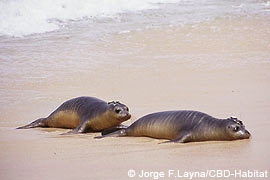 |
|
|
A pair of monk seals born at Cabo Blanco were subsequently tracked moving towards the Banc D’Arguin area. |
Monk seal presence in the National Park of Banc D’Arguin (PNBA) has always been considered irregular and scarce. Nevertheless, sightings collected as a result of recent interviews with fishermen of the different villages inside the National Park, has indicated that monk seal presence inside the boundaries of the Park is more regular than originally thought.
Results of the interviews, performed by PNBA personnel in collaboration with CBD-Habitat, show how local fishermen are aware of monk seals and have had some encounters with them in the Park during their lives. Encounters are not regular, but due to the low population inhabiting the Park, its large shoreline and marine extension, as well as the labyrinthine channels that form its sandbanks and its shallow waters, monk seal feeding presence inside the National Park limits may well be higher than first supposed — these factors all adding to the difficulty in locating or sighting them.
Two animals born in the Cabo Blanco colony and tracked by telemetry devices, showed movements towards the Banc D’Arguin area, where they stayed for more than a month before they returned back north to the Cabo Blanco peninsula.
Such information suggests that the PNBA is an important area for the monk seals of the Cabo Blanco colony, and that its role in the conservation of the species should be evaluated in the future, taking into account the high intensity fishing activity, both industrial and artisanal, which takes place outside its boundaries. – Miguel Angel Cedenilla & Pablo Fernández de Larrinoa, CBD-Habitat.
Mediterranean News continues with Turkey...
Copyright © 2004 The Monachus Guardian. All Rights Reserved |